After spending a couple of days seeing the religious sights in Lourdes, we drove for about two hours to Bayonne, known as one of the prettiest cities in southwest France, the 'capital' of the French Basque area, and also a strategic stronghold since medieval times. As we entered the city to basically just see its famous cathedral, we noticed how the buildings were decorated in a lovely mixture of Basque and French architecture, each adorned with colorful wooden shutters.
The windows along with the spectacular vibrant paintings were the best features of the cathedral in my opinion.
The huge 18th century unsigned painting of The Last Supper was donated to the Cathedral by a rich merchant. In the painting, the scene was lit by a huge oil lamp. The apostles John and Peter were on either side of Christ while Judas was on his left holding a purse, the symbol of his treason.
The Town Hall was planned in 1819 by Napoleon Bonaparte's brother, Jose, and built between 1828 and 1832.
On the other side, the St. Barbara Altar attested to the close relationship between the church and the city as the construction of the altar was promoted by the artillerymen stationed nearby because she was the patron saint of the artillery.
The Battery of St. James on the upper part of Urgull served as a large level space for the artillery until the first half of the 18th century when it was turned into a battery for defending the land front. In the 19th century, the area was changed to give firing access onto the sea front as well by placing two Ordonez canons here which could be aimed toward the ocean.
Written evidence indicated the first fortification work on Monte Urgull was in the 12th century, when the Kingdom of Navarre had a square-towered castle built on the rocky hilltop. The primitive La Mota Castle went through many changes over the centuries and the old tower was replaced with work carried out by the House of Austria in 1552. After the castle was seriously damaged in 1868 as a result of an explosion in the nearby gunpowder depot, major renovations took place.
Because of Bayonne’s commercial importance and its close proximity to Spain, about 25 miles away, the city had many fortified structures. Most of the original wall that surrounded the city was gone but we were still able to see some of the remnants as we wandered toward the cathedral located in the Old Town.
The city grew with help from the whaling and cod industries, as well as Basque sailors who returned with spices and riches from far off lands. This influx of money helped finance many of the city’s buildings, including the massive Gothic cathedral.
The Cathedral of Our Lady of Bayonne, commonly known as Bayonne Cathedral, dominated the city’s skyline; we had first seen its spires on the outskirts. The construction of the UNESCO-listed Gothic cathedral started in 1213 and wasn’t finished until the 17th century with exception of the north tower and the spires that were completed in the 19th century.
I was awestruck when we stepped inside the cathedral. It was so peaceful and serene. The art, architecture, and stained-glass were all amazing. It was truly a special moment.
Each panel of stained glass was a piece of art. Some of them
dated to the sixteenth century.
The windows along with the spectacular vibrant paintings were the best features of the cathedral in my opinion.
The Education of the Virgin was painted by Jean Bardin, a neoclassical painter. We could see the temple where Mary was educated from the age of three. The curtain she's seen as emerging from will be torn when Christ dies. An angel holds a crown of ten white roses above Mary's head as a sign of divine election. The Virgin is seen kneeling on a parchment; above her was her mother, St. Anne, chatting with Zachariah.
We only had time to see the cathedral in Bayonne before driving toward San Sebastian, a city in the Spanish Basque region. First, a little background on Basque Country, thanks to travel writer Rick Steves. The ancient free-spirited land of the Basques straddles both France and Spain on the Atlantic Coast, stretching about 100 miles from Bayonne to Bilbao, Spain, our destination later that day. Insulated from mainstream Europe for much of their history, the Basques have wanted to be left alone for more than 7,000 years.
Much unites the French and Spanish Basque regions: they share a cuisine, a Union Jack-style green, red and white flag, and a common language, Euskara, spoken by about a half-million people, although virtually everyone speaks French and/or Spanish. Both have been also integrated by their respective countries, sometimes forcibly. The French Revolution quelled French Basque ideas of independence; 130 years later, Spain's fascist dictator, Generalissimo Francisco Franco, attempted to tame his own separatist-minded Basques.
Euskara, related to no other surviving language, has been used since Neolithic times, making it very likely the oldest European language that's still spoken. Kept alive as a symbol of Basque cultural identity, Euskara is typically proudly learned as a second or third language.
The Basque economy was shaped by three factors: the sea, agriculture and iron deposits. Basque sailors were some of the first and finest in Europe, as they built ever better boats to venture further and further into the Atlantic in search of whales. By the year 1000, Basque sailors were chasing whales a thousand miles from home in the Norwegian fjords!
When the Spanish era of exploration began, Basques continued to play a key role as sailors and shipbuilders. Columbus' boat, the Santa Maria, was likely Basque built. When Ferdinand Magellan, the first to circumnavigate the globe, was killed partway around, it was his Basque captain, Juan Sebastian Elcano, who took over. I had never realized before this that both St. Ignatius of Loyola and St. Francis Xavier, known for their far-reaching missionary trips that led to founding the Jesuit order, were also Basques. Did you realize that, Andrew?
Perhaps you've also heard of much of the news of the Basques in recent years, especially in Spain. Much has been made by the terrorist organization ETA, whose goal was to establish an independent Basque state. ETA has been blamed for more than 800 deaths since 1868, but in recent years, the group has disarmed and declared an end to its campaign of violence, but not its call for independence.
Our first introduction to Euskara was seeing this road sign welcoming us to Pais Vasco, the Basque Country or region in north central Spain. We were lucky that for the next several days we spent in the Basque area, we never saw any of the Spanish names on the signs scratched out by locals as it would have been very difficult to navigate by Euskara names alone!
An hour's drive from Bayonne was San Sebastian, or Donastia in Euskara, the heart of of the tourist's Pais Vasco, and known for its "sparkling picturesque beach framed by looming green mountains and a charming old town with gourmet tapas or pintxos spilling out of every bar." Because the rainy weather was still dogging us, we weren't sure whether anything would be 'sparkling' but we couldn't wait to see the city anyways.
San Sebastian was born abut 1,000 years ago but the town burned down in 1813 as Spain, Portugal and England fought the French to get Napoleon's brother off the throne.
We thought wandering through the sandstone Brexta Public Market would be a fun way to get in touch with San Sebastian and Basque culture. The produce vendors were under the eaves of the building.
Inside, at the back of the market were the fresh fish stands but, since it was a Monday, few of them were open because the boats don't go out on Sundays, the fishermen's day of rest.
On the glass half full side, though, it meant there were no people blocking the cute mosaics in the floor!
Just outside the market entrance was a memorial to Andresa Portugal who was born in 1915. At the end of the Spanish Civil War in 1939, she began selling fish in the area around the Brexta market. Like the other fishmongers, she displayed her fish on a wooden board, which she used to clean the fish for her customers. She worked like this for over 70 years and was the last person to do so. Because she was so well loved by the locals, she received a Citizen's Merit Medal from the San Sebastian Town Council in 2012.
It seems almost sacrilegious to say in a city known as a culinary capital of Spain that we stopped into the McDonald's right by the market for a snack but it was convenient and we needed a break after the longish drive from Lourdes. It had a McCafe with divine looking pastries including cheesecake, a death by chocolate cake, and my favorite, a carrot cake. I was in high heaven or should I say, hog heaven!
Across from the market was the Aitor Lasa cheese shop with its fragrant piles of mushrooms at the entrance. At the back of the small shop were many varieties of idiazabal, a Basque specialty raw sheep's milk cheese. The price depended on the specific region it came from, whether it was smoked or cured and for how long it'd been cured.
Zachary: We thought of you when we saw all these snow globes.
When we saw this shop selling shoes and purses made of chocolate, I had to stop in! I was proud of myself when I limited myself to one chocolate bonbon filled with caramel - yum, yum.
St. Vincent Martir's Church was mostly built in the 16th century except for the portico and rosettes on the walls which were added in the 17th and 20th centuries, respectively. The church seemed to be closed but had some unusual sculptures out front for a church. This exhibition of six large bronze works by Basque painter and sculptor Eduardo Chillida was first shown in Paris' Louvre Square in 2017.
From the church, we wandered through more of the old town where we noticed ready-made pintxos were visible in every bar we passed.
I wish I knew more about Basque history and recent events to understand the meaning of this.
Here was our first sight of the Basque flag.
The old town's main square, Plaza de la Constitucion, was where bull fights used to be held. In 1820, New Square was renamed Constitution Square in honor of the constitutional regime which came into being that year. Nowadays, the square is used for the city's major celebrations.
The seats on the balconies were all numbered. Even if people owned an apartment here, the city retained the rights to the balconies which it could sell as box seats. The residents could, though, peek over the paying customers' shoulders!
The Town Hall was planned in 1819 by Napoleon Bonaparte's brother, Jose, and built between 1828 and 1832.
Above the clock was the seal of San Sebastian: a merchant ship with sails billowing in the wind. The city was granted trading rights by the crown, a reminder of the Basque Country's importance in seafaring.
There were several bars in the plaza's arcades. The pintxos at this one looked particularly inviting but we'd just snacked at Mickey D's!
At the end of the narrow alley was the striking Bailica of St. Mary, one of the oldest sites in the city as various temples had been erected on that spot since the 12th century. The current church was built between 1743 and 1774.
So ornate was the facade it was tough to know where to look. In the center was the Virgin Mary looking up to heaven with a dove representing the Holy Spirit surrounded by clouds.
The Virgin was flanked by both her parents, St. Joachim and St. Anne, who were shown looking at the Virgin.
The High Altar was made by Diego de Villanueva in the 18th century and its central section was dedicated to Our Lady of the Chorus and St. Sebastian, both patron saints of the city.
Twin altars, also made by de Villanueva, lay at either side of the high altar. The St. Pius V Altar depicted one of the saint's miracles when a crucified Christ moved his feet away to prevent St. Pius from dying as they'd been covered in poison.
One altarpiece I really liked was the one of St. Antonius which stood for a saint of great veneration during the Baroque period. It portrayed a kneeling saint that was holding the baby Jesus in his arms.
On the left was St. Homobonus, a saint I'd never heard of. I guess I mustn't have been paying attention during that part of my Catechism class when I was young! He was a merchant and patron saint of the city's tailors, which wasn't surprising given their number in San Sebastian.
The city of San Sebastian no longer holds major Easter processions like it used to. When it did, this 17th century Descent from the Cross was carried through the streets.
After seeing and admiring the church's traditional altars and architecture, it was strange coming across very modern artwork in the church. A pamphlet explained that contemporary art was present in the basilica as a reminder of the religiosity of present-day society. This 2007 sculpture represented The Martyrdom of Sebastian and "staged a martyrdom taken to its final expression." I was glad to have the interpretive notes as I certainly didn't know what it would have been otherwise.
This sculpture also depicted the martyrdom of Sebastian.
I naively thought initially this was part of a sound system until I read it was called a Living Shelter and consisted of a suspended piece. In the artist's words, "It attempts to get inside the evocative side of the internal personal world."
Eduardo Chillada sculpted this cross in alabaster in 1975 following a trip to Greece. He explained that he saw "the Cross as the encounter with humanity and it stands for forgiveness."
It was only when I left the basilica I noticed the unusual modern sculpture out front. Somehow it made sense having just seen the contemporary pieces inside. Though caught off guard by the ultramodern art initially, I admired the church elders for moving with the times.
We climbed a hill above the basilica for some panoramic views of the city.
From there, we began climbing up a strenuous path to Monte Urgull and the Castillo de la Mota, the castle atop the hill which deterred most attackers and therefore enabled the city to prosper in the Middle Ages.
It was remarkable being in a forest just minutes away from the hustle and bustle of the city.
From near the top we had spectacular views of the city and also of the breathtaking Concha Bay.
In 1845, Queen Isabel II's doctor recommended she treat her skin problems by bathing here at San Sebastian. You'll be amused to know that, for modesty's sake, she went inside a giant cabana that could be wheeled into the surf which allowed her to swim far from prying eyes so that she never needed to set foot on the beach!
Her visit mobilized Spain's aristocracy, so that soon San Sebastian was on the map as a seaside resort. By the turn the 20th century, the city was a leading resort for Europe's beautiful people. Before WWI, Queen Maria Cristina spent summers here and held court in her Miramar Palace.
Around the bay was beautiful Clara Island.
Just ahead finally was a large statue of Christ that overlooked the bay.
A crumbling memorial commemorated the British soldiers who gave their lives to defend the city from Napoleon.
Once we hiked down to the waterfront, we wandered for a while along the paseo de los curas or priests' path where the clergy could stroll unburdened by people in the streets.
If you're reading this, Zachary, I had Dad drive all the way around the bay to the beach on the off chance I could find some more shells for you. It meant I had to jump out of the car while he then had to try and navigate around the block by himself. I then ran down to the beach, looked madly for shells and then hurried back to meet him in a bus zone! All that to say, hon, we both tried getting some more shells for you but all I saw was sand, and nothing but sand on the lovely beach. Sorry about that, sweetheart!
Those weren't whales so close to the shore but surfers in wet suits hoping to catch a big wave!
After a really fun half day in San Sebastian, we still had a 90 minute drive to Bilbao, our 'home away from home' for the next several days. No wonder Steven looked relaxed with a glass of wine after a long day of driving from Lourdes to Bayonne to San Sebastian and finally Bilbao!
Next post: Discovering Bilbao's fabulous Guggenheim Museum and more.
Posted on December 16th, 2018, in Porto, Portugal.


















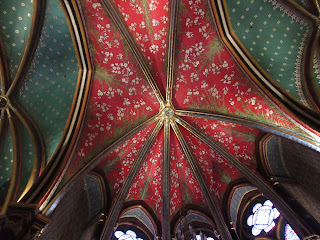






























































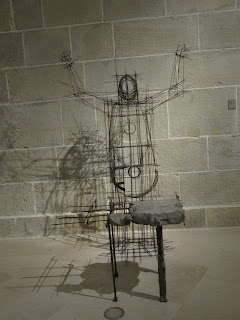






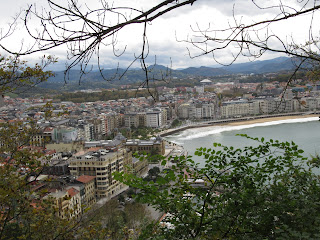






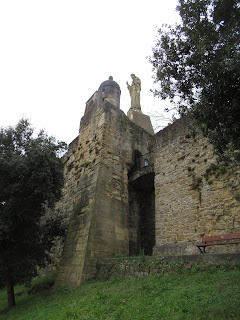











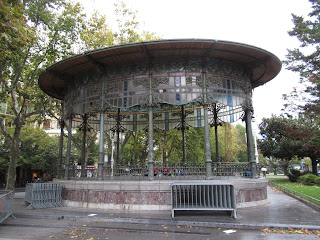
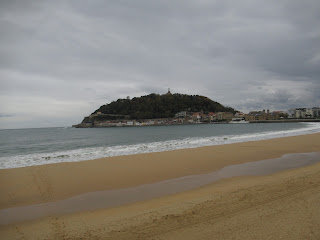


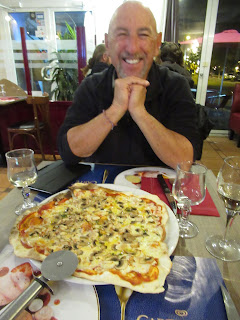
One of the specialists on our Nat Geo Patagonian cruise was from the Spanish Basque country. He is a PHD in Glaciers – we visited one of the ones that he studied. He spoke English, but, at times it was difficult to understand him. People told me about the ancient language – Euskara. It was an accent that I had never heard before. He was an interesting young man. Janina K
ReplyDeleteYou were luckier than we were, Janina, in that I don't recall hearing anyone speaking Euskara while we were in the Basque region.
ReplyDelete